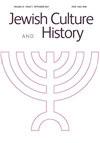Introduction: Jewish cultural heritage, space and mobility in Spain, Portugal and North Africa
Q4 Arts and Humanities
引用次数: 0
Abstract
A traditional definition of cultural heritage, tangible and intangible, includes all assets that have a symbolic cultural value: from historic towns, buildings, cultural landscapes and cultural objects to intangible manifestations that usually fall into the category of folklore and ‘popular culture’. They are a unique set of cultural manifestations created under particular social, cultural, and economic circumstances, which are impossible to recreate truly. The speed with which the world is changing places heritage at a risk of being lost through physical destruction or loss of knowledge. National and international organisations have sought to establish a formal system of identifying a sample of that heritage and conserving it for the future. As it cannot include everything, determining the best or most representative samples or things to preserve is not always a politically or ideologically neutral decision (Messenger and Smith, 2010,Waterton 2012). The UNESCO and the Council of Europe have been very active in the area of cultural heritage. Among the issues of interest for these organisations in the broad field of culture are cultural identity and the recognition of minorities (Richards 1996). Since the 1990s, studies on ‘place’ and ‘space’ have contributed to rethinking the concept of heritage (Brauch, Lipphardt, Nocke 2008). If the concept of ‘heritage’ refers to the past, the concept of ‘space’ refers to the dynamic relationships that occur – alongside many other areas – around heritage, its use, interpretation, (re)creation of identities, and construction of social relationships (Breglia 2006). That is, not as something stable and fixed but as something symbolic and fluid (Gromova and Voigt, 2015). As Diana Pinto pointed out, in the mid-1990s, when she coined the concept of ‘Jewish space’, cultural heritage and other Jewish cultural spaces in Europe would inevitably come from the hand not only of Jews but often of non-Jews (Pinto 1996). The transformation in tourist products of old Jewish neighbourhoods in Europe is one such example for a form of coconstruction of memories and, even, identities (Eszter 2014). As Joan and Jean Comaroff have argued, ethnicity and cultural heritage have become a commodity, a market product (of those in the margins, the exoticised ‘others’) to be consumed (Comaroff and Comaroff, 2009). This raises crucial questions about who’s heritage and identity are distinguished for preservation, by whom, why, and how.简介:犹太文化在西班牙、葡萄牙和北非的传承、空间和流动性
有形和无形文化遗产的传统定义包括具有象征性文化价值的所有资产:从历史城镇、建筑、文化景观和文化物品到通常属于民间传说和“流行文化”类别的非物质表现形式。它们是在特定的社会、文化和经济环境下创造的一组独特的文化表现形式,不可能真正重现。世界变化的速度使遗产面临着因物理破坏或知识丧失而丧失的风险。国家和国际组织试图建立一个正式的系统来识别该遗产的样本并为未来进行保护。由于它不可能包括所有东西,因此确定最好或最具代表性的样本或要保存的东西并不总是一个政治或意识形态中立的决定(Messenger和Smith,2010,Waterton 2012)。教科文组织和欧洲委员会在文化遗产领域一直非常积极。这些组织在广泛的文化领域感兴趣的问题包括文化认同和对少数民族的承认(Richards,1996)。自20世纪90年代以来,对“地点”和“空间”的研究有助于重新思考遗产的概念(Brauch,Lipphardt,Nocke,2008)。如果“遗产”的概念指的是过去,那么“空间”的概念则指的是围绕遗产、遗产的使用、解释、身份的(再)创造和社会关系的构建(Breglia,2006年),与许多其他领域一起发生的动态关系。也就是说,不是作为稳定和固定的东西,而是作为象征和流动的东西(Gromova和Voigt,2015)。正如戴安娜·平托所指出的,在20世纪90年代中期,当她创造了“犹太空间”的概念时,欧洲的文化遗产和其他犹太文化空间不可避免地不仅来自犹太人,而且往往来自非犹太人(平托,1996年)。欧洲古老犹太街区旅游产品的转变就是一种记忆甚至身份共同构建的例子(Eszter 2014)。正如Joan和Jean Comaroff所说,种族和文化遗产已经成为一种商品,一种需要消费的市场产品(边缘人群、异国情调的“其他人”)(Comaroff和Comaroff,2009)。这就提出了一个关键问题,即谁的遗产和身份是为了保护而区分的,由谁、为什么以及如何区分。
本文章由计算机程序翻译,如有差异,请以英文原文为准。
求助全文
约1分钟内获得全文
求助全文

 求助内容:
求助内容: 应助结果提醒方式:
应助结果提醒方式:


